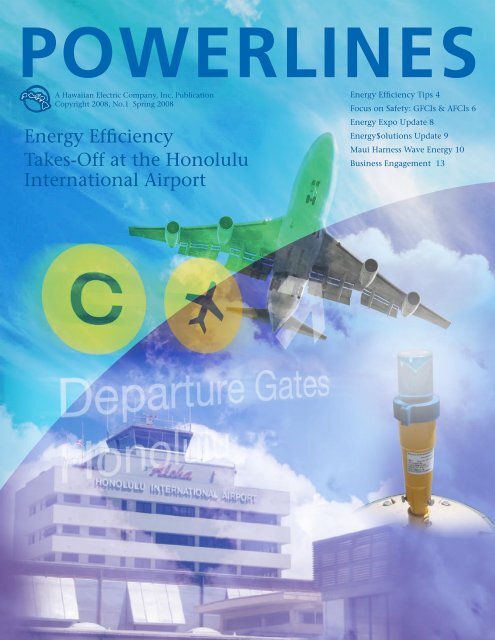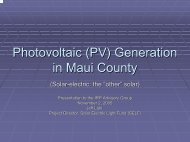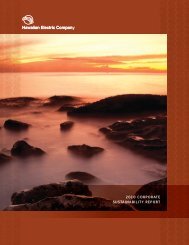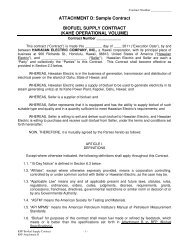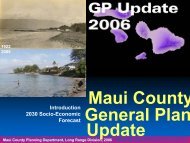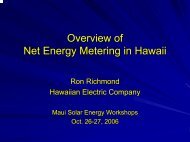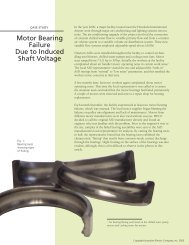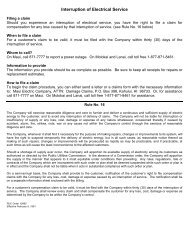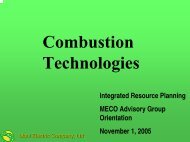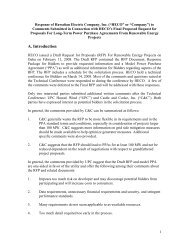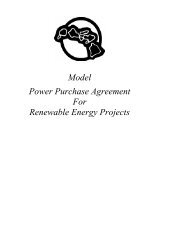Energy Efficiency Takes-Off at the Honolulu International ... - Heco.com
Energy Efficiency Takes-Off at the Honolulu International ... - Heco.com
Energy Efficiency Takes-Off at the Honolulu International ... - Heco.com
- No tags were found...
Create successful ePaper yourself
Turn your PDF publications into a flip-book with our unique Google optimized e-Paper software.
To OurValuedCommercialCustomersALOHA! Our Spring Issue is packed fullof helpful tips on staying safe and savingenergy.• <strong>Honolulu</strong> Intern<strong>at</strong>ional Airport utilizeshigh-intensity LED technology in <strong>the</strong>taxiway light fixtures and guidancesigns.• Top ten tips to assist <strong>com</strong>mercial andresidential customers be<strong>com</strong>e moreenergy efficient• Learn how GFCIs and AFCIs can helpto prevent electric shock and fire.• MECO and Oceanlinx partner todevelop an innov<strong>at</strong>ive andenvironmentally based wave energyproject.Mark your calendars for HECO’s 2008Efficient Electro-Technology Exposition& Conference, which will be held onThursday, September 18, 2008 <strong>at</strong> <strong>the</strong>Hawai’i Convention Center. We lookforward to seeing you!Mahalo,Dr. Karl E. StahlkopfSenior Vice President of <strong>Energy</strong>Solutions and ChiefTechnology <strong>Off</strong>icer<strong>Energy</strong> <strong>Efficiency</strong><strong>Takes</strong>-<strong>Off</strong> <strong>at</strong> <strong>the</strong><strong>Honolulu</strong> Intern<strong>at</strong>ionalAirportAs part of a bold and str<strong>at</strong>egic energy plan th<strong>at</strong> encourages and supportsmarket-based development of reliable, cost-effective, and self-reliant energy forHawai’i, Governor Linda Lingle issued Administr<strong>at</strong>ive Directive No. 06-01(<strong>Energy</strong> and Resource <strong>Efficiency</strong> and Renewable <strong>Energy</strong> and ResourceDevelopment) in January 20, 2006. This directive st<strong>at</strong>es in part th<strong>at</strong> St<strong>at</strong>eagencies must assess <strong>the</strong>ir practices and programs to reduce energy use inorder to establish a secure energy and economic future for <strong>the</strong> people ofHawai’i. <strong>Honolulu</strong> Intern<strong>at</strong>ional Airport, one of <strong>the</strong> most energy-intensivefacilities on <strong>the</strong> island of Oahu was <strong>the</strong> first St<strong>at</strong>e of Hawai’i – Department ofTransport<strong>at</strong>ion (DOT) Airports Division’s facility to take action towardssaving energy, cutting costs, and improving its sustainability. With $4 millionin funds, energy efficiency projects tookoff in 2007 with <strong>the</strong> replacement of <strong>the</strong>airfield taxiway light fixtures andguidance signs.Taking advantage of <strong>the</strong> increasedperformance and lowered cost ofhigh-intensity Lighting Emitting Diode(LED) technology, <strong>the</strong> DOT AirportsDivision’s team of engineers wereable to replace all of <strong>the</strong> 30-w<strong>at</strong>tincandescent taxiway lamps with 1-w<strong>at</strong>t high-intensity LED lamps. Along with<strong>the</strong> lamps, <strong>the</strong> 30/45-w<strong>at</strong>t isol<strong>at</strong>ion transformers were also replaced with lowerw<strong>at</strong>tage more efficient transformers. Each taxiway light fixture uses an isol<strong>at</strong>iontransformer to isol<strong>at</strong>e low-voltage in <strong>the</strong> lamp from <strong>the</strong> high oper<strong>at</strong>ing voltagepresent on <strong>the</strong> airfield series of lighting circuits. When one of <strong>the</strong> lamps fails,<strong>the</strong> isol<strong>at</strong>ion transformer plays a key role in helping to prevent <strong>the</strong> interruptionof power to <strong>the</strong> remaining loads.2
The overall w<strong>at</strong>tage reduction for <strong>the</strong>entire taxiway lighting system (lampand isol<strong>at</strong>ion transformer) wasestim<strong>at</strong>ed to be 36-w<strong>at</strong>t per fixture.This is based upon efficiencies listedunder <strong>the</strong> Siemens Elev<strong>at</strong>ed TaxiwayEdge Light product specific<strong>at</strong>ions. With<strong>the</strong> retrofit of 1755 taxiway lights andisol<strong>at</strong>ion transformers, <strong>Honolulu</strong>Intern<strong>at</strong>ional Airport was able to achievea reduction in energy consumptionof nearly 300,000 kWh per year andsavings of more than $27,000 on <strong>the</strong>irannual electric bill. In addition to <strong>the</strong>energy and dollar savings, HawaiianElectric Company, Inc. (HECO)<strong>Energy</strong>$olutions SM for Business programprovided a customized reb<strong>at</strong>e ofover $19,000.Benefits from using this new class ofhigh-intensity LED <strong>com</strong>es from <strong>the</strong>extensive lifetime of <strong>the</strong> lamp. TheSiemens Sign<strong>at</strong>ure SeriesL-861T LED Elev<strong>at</strong>ed Taxiway Edge LightLEDs used in <strong>the</strong> taxiway light fixtures<strong>at</strong> <strong>Honolulu</strong> Intern<strong>at</strong>ional Airport havean average life of 100,000 hours underhigh-intensity conditions and more than200,000 hours under actual oper<strong>at</strong>ingconditions. With a far gre<strong>at</strong>er lifeexpectancy than conventionalincandescent lamps (i.e., 1000 hours),<strong>the</strong>re is a significant potential for savingsin both maintenance costs as well asreduction in oper<strong>at</strong>ional disruptions.Additional energy efficiency measuresimplemented <strong>at</strong> <strong>the</strong> airport were <strong>the</strong>retrofitting of 286 guidance signs. Themain purpose of <strong>the</strong>se signs is to guidepilots to a particular point on <strong>the</strong>airfield, identify holding positions,identify taxiway and runwayintersections, and prohibit aircraft entryinto design<strong>at</strong>ed areas. The oldguidance signs, internally illumin<strong>at</strong>edby two or more 50-w<strong>at</strong>t high-pressuresodium (HPS) lamps, were replaced withnew Siemens’ Sign<strong>at</strong>ure Series guidancesigns, which use 18-w<strong>at</strong>t pin mount<strong>com</strong>pact fluorescent lamps (CFLs). Eachnew guidance sign is made of two tofour modules containing two lamps permodule, thus <strong>the</strong> total number of CFLlamps installed for 286 guidance signs is1422 CFLs.As a result of <strong>the</strong>se new energy efficientguidance signs replacement, <strong>Honolulu</strong>Intern<strong>at</strong>ional Airport saved anadditional 300,000 kWh in energyconsumption per year and received astandard reb<strong>at</strong>e of over $14,000 underHECO’s <strong>Energy</strong>$olutions SM for Businessprogram. The CFL provides a moreuniform distribution of light, makingguidance signs more readable.The next energy efficiency “arrival”from <strong>Honolulu</strong> Intern<strong>at</strong>ional Airport is<strong>the</strong> replacement and reloc<strong>at</strong>ion of <strong>the</strong>Diamond Head Chiller Plant. The newchiller plant will have <strong>the</strong> capability toair-condition <strong>the</strong> entire airport while<strong>the</strong> Ewa and Overseas/Main TerminalChiller Plants undergo separ<strong>at</strong>erenov<strong>at</strong>ions. In fact, <strong>the</strong> three chillerplants will be consolid<strong>at</strong>ed into one centralplant. This project is already on itsway and it will be <strong>the</strong> subject of a futurePowerlines public<strong>at</strong>ion.<strong>Energy</strong> Savings Highlights:Annual Savings $54,000Annual kWh Reduction 600,000HECO Reb<strong>at</strong>es $33,0003
Hawai’i is highly dependent on imported fuel forits energy and transport<strong>at</strong>ion needs. In 2008, <strong>the</strong>US has seen energy pricing rise to record levelswith oil prices breaking <strong>the</strong> $100/barrel threshold.As a result, gasoline prices have increased and <strong>the</strong>cost to drive a car to work, school, or <strong>the</strong> store isbe<strong>com</strong>ing a significant monthly expense. Withless available spending money, many localresidents are forced to control <strong>the</strong>ir spendingand cut costs to cope with a higher cost of living.<strong>Energy</strong> conserv<strong>at</strong>ion is be<strong>com</strong>ing more important.People are planning <strong>the</strong>ir trips to <strong>the</strong> store morecarefully. Some are carpooling or taking masstransit altern<strong>at</strong>ives. O<strong>the</strong>rs are considering buyinga fuel efficient hybrid r<strong>at</strong>her than a large SUV. In<strong>the</strong> home, <strong>com</strong>pact fluorescent lamps (CFLs) arereplacing incandescent light bulbs. Openwindows or fans are cooling homes instead ofrunning <strong>the</strong> air conditioning units.<strong>Energy</strong> <strong>Efficiency</strong> Tipsto help Lower<strong>Energy</strong> Bill and Benefit <strong>the</strong>EnvironmentRising fuel costs, higher oper<strong>at</strong>ing expenses andincreasing concerns of global warming haveprompted many large <strong>com</strong>panies to focus onenergy conserv<strong>at</strong>ion through energy efficiencyimprovements as one way to control expensesand improve profits. These <strong>com</strong>panies realize th<strong>at</strong>energy efficiency improvements are <strong>the</strong> only wayto control energy costs. With energy prices risingeach year and increasing concerns of globalwarming from carbon emissions, efficiencyimprovements and energy conserv<strong>at</strong>ion measuresare <strong>the</strong> least-cost options to managing energycosts. Hawaiian Electric Company, Inc. (HECO)and its subsidiaries Hawaii Electric Light Company(HELCO) and Maui Electric Company (MECO)are supportive of energy efficiency improvementsby providing reb<strong>at</strong>e programs for localbusinesses and residents. Since <strong>the</strong> launch ofHECO’s <strong>Energy</strong>$olutions SM for Business reb<strong>at</strong>eprograms, over $27 million dollars have been paidto customers who have implemented energyefficiency improvements. <strong>Energy</strong> efficiency saved402 million kilow<strong>at</strong>t hours of energy or almost670,000 barrels of oil th<strong>at</strong> would have been usedby our power plants every year.4
energy efficiency & conserv<strong>at</strong>ion improvementsTo assist local businesses and residents, HECO has <strong>com</strong>piled <strong>the</strong> top ten lists of energy efficiency / conserv<strong>at</strong>ion improvementsfor businesses and homes:No. Commercial Residential1 Upgrade interior and exterior lighting to more energyefficient fixtures. Replace standard incandescentlight bulbs and consider <strong>com</strong>pact fluorescent lamps(CFLs), T-8, and T-5 lamps.2 Upgrade existing air conditioning systems to moreenergy efficient equipment.3 Install or replace old motors with premium efficiencymotors and variable frequency drives.4 Install solar w<strong>at</strong>er he<strong>at</strong>ing system or electronic he<strong>at</strong>pump to he<strong>at</strong> w<strong>at</strong>er.Install a solar w<strong>at</strong>er he<strong>at</strong>ing system or a high efficiencyelectric w<strong>at</strong>er he<strong>at</strong>er.Replace standard incandescent light bulbs with newenergy efficient <strong>com</strong>pact fluorescent lamp (CFL) bulbs.Replace existing shower heads with new low flow unitswhich use less hot w<strong>at</strong>er.Turn down <strong>the</strong> <strong>the</strong>rmost<strong>at</strong> on your electric w<strong>at</strong>er he<strong>at</strong>erto 120° Fahrenheit.5 Install occupancy sensors for 24 hour lighting areas. Use <strong>the</strong> sun to dry clo<strong>the</strong>s instead of using <strong>the</strong> electricdryer.6 Consider Demand Control Ventil<strong>at</strong>ion (DCV) systemsto adjust and control outside airflow to m<strong>at</strong>ch currentbuilding needs.7 Consider energy management systems to controlair conditioning, ventil<strong>at</strong>ion, and lighting systems tooper<strong>at</strong>e equipment only when necessary and avoidrunning equipment unnecessarily.Turn off lights or electronic equipment like televisionswhen leaving <strong>the</strong> room.Install new energy efficient “<strong>Energy</strong> Star” Appliances.8 Consider window tinting. Install occupancy sensors indoors and outdoors(security lights).9 Consider daylighting systems with lighting controls toillumin<strong>at</strong>e a room or office.10 Consider supply air reset techniques and controls toadjust supply air temper<strong>at</strong>ure setpoints during lowoccupancy periods.Use a power strip to conveniently turn off electronicequipment for cell phones, printers, DVD players, VCRs,televisions, radios, and o<strong>the</strong>r electronic equipment th<strong>at</strong>is not being used.Shut-off <strong>com</strong>puters and monitors when leaving <strong>the</strong>room for more than 20 minutes.For more inform<strong>at</strong>ion on <strong>the</strong>se and o<strong>the</strong>r energy solutions, <strong>com</strong>mercial and residential customers can contact HECO <strong>at</strong>94-POWER or visit our website <strong>at</strong> www.heco.<strong>com</strong>.5
Focus on Safety: GFCIs & AFCIsVarious Types ofGround-Fault Circuit-InterruptersThe ground-fault circuit-interrupters(GFCIs) and arc-fault circuit-interrupters (AFCIs) are two differentelectrical devices th<strong>at</strong> serve distinctpurposes. A GFCI is designed toprevent electrical shock. It has beenestim<strong>at</strong>ed th<strong>at</strong> if GFCIs are installed inhousehold branch circuits, <strong>the</strong>y couldprevent about two-thirds of <strong>the</strong>approxim<strong>at</strong>ely 300 accidentalelectrocutions th<strong>at</strong> happen in andaround <strong>the</strong> home each year. 1Likewise, AFCIs could save lives as wellas prevent property loss through <strong>the</strong>iruse and install<strong>at</strong>ion. In this article wewill discuss:• How GFCIs work and why <strong>the</strong>y areimportant• How AFCIs work and why <strong>the</strong>y areimportant• Code issues concerning GFCIs andAFCIs1www.cpsc.gov/cpscpub/pubs/99.html, ConsumerProduct Safety Commission, GFCIs Fact Sheet, 1996.2Ibid.Ground-Fault Circuit-Interrupters (GFCIs)A GFCI is a device th<strong>at</strong> interrupts an electrical circuit when a ground-faultis detected. It is specifically designed to prevent electric shock when aperson <strong>com</strong>es into contact with an electrically energized part. The deviceis only applicable for 120-volt, single-phase circuits. The GFCI oper<strong>at</strong>es by<strong>com</strong>paring <strong>the</strong> current between <strong>the</strong> hot p<strong>at</strong>h to <strong>the</strong> load (an appliance orlight, for example) and <strong>the</strong> neutral or return p<strong>at</strong>h. If an imbalance as littleas 5 milliamps exists for a period as short as 2 cycles (33 milliseconds), <strong>the</strong>device will trip <strong>the</strong> circuit. A current imbalance condition between <strong>the</strong> hotand neutral p<strong>at</strong>h indic<strong>at</strong>es a ground fault wherein current is somehowbeing diverted to a ground p<strong>at</strong>h. 2 An example of a shock hazard conditioninvolving a ground fault would be if someone were standing barefoot ona wet concrete floor and <strong>com</strong>ing into contact with an extension cord withbroken insul<strong>at</strong>ion th<strong>at</strong> exposing bare live wire. As one can surmise fromthis example, a GFCI <strong>at</strong> <strong>the</strong> electric receptacle where <strong>the</strong> cord is plugged incould be lifesaving. For older homes with 2-wire 125-volt receptacles, <strong>the</strong>install<strong>at</strong>ion of a GFCI receptacle or plug-in module will still protect againstground-faults.GFCIs are available as ei<strong>the</strong>r receptacles (<strong>the</strong>y are now required by code inb<strong>at</strong>hrooms, kitchens, basements, garages, and o<strong>the</strong>r places where w<strong>at</strong>ermay be present), plug–in modules for use with power tools, and part of <strong>the</strong>cord-plug <strong>com</strong>bin<strong>at</strong>ion of certain appliance such as hair dryers and circuitbreakers. GFCIs include test/reset pushbuttons and <strong>the</strong>se devices should betested after install<strong>at</strong>ion and monthly according to Underwriters Labor<strong>at</strong>ory.6
Code Issues Concerning GFCIs and AFCIsArc-Fault Circuit-Interrupters(AFCIs)An AFCI is a device th<strong>at</strong> interrupts an electricalcircuit when an arcing fault is detected. Itis specifically designed to prevent a fire whenan arcing current is detected. The deviceis only applicable for 120-volt, single-phasecircuits. The device works by tripping <strong>the</strong>protected circuit when a waveform typical ofan arc-fault current is detected. It can distinguishbetween inrush current, arcing currentwhen a switch is in oper<strong>at</strong>ion, and <strong>the</strong> kindof unintended arcing current th<strong>at</strong> can posea fire hazard. These types of hazardous arcscan occur <strong>at</strong> loose connections and termin<strong>at</strong>ionsor where wire insul<strong>at</strong>ion has be<strong>com</strong>edamaged. 3AFCIs are available as circuit breakers and alsoinclude a test pushbutton. As with GFCIs,AFCIs should be tested after <strong>the</strong>y are installedas well as once per month. Combin<strong>at</strong>ionGFCI-AFCI circuit breakers are also available. 4Arc-Fault Circuit-Interrupter Circuit BreakersMost municipalities, including Hawai’i, require th<strong>at</strong> <strong>the</strong> install<strong>at</strong>ion of electricalsystems within residential and <strong>com</strong>mercial buildings follow N<strong>at</strong>ionalElectric Code (NEC) requirements. Article 210 of <strong>the</strong> NEC governs <strong>the</strong>requirements for GFCI and AFCI applic<strong>at</strong>ions as <strong>the</strong>y apply to branch circuitprotection.Section 210.8 of <strong>the</strong> NEC - Ground-Fault Circuit-Interrupter Protectionfor Personnel - covers <strong>the</strong> GFCI requirements for residential dwelling unitsand <strong>com</strong>mercial buildings. Section 210.8 (A) lists <strong>the</strong> specific loc<strong>at</strong>ionsin dwelling units where GFCI branch circuit protection is required. Theseloc<strong>at</strong>ions include b<strong>at</strong>hrooms, garages, outdoors, crawl spaces <strong>at</strong> or belowgrade, unfinished basements, kitchens, areas around laundry and wet barsinks, and bo<strong>at</strong> houses. Section 210.8 (B) lists <strong>the</strong> specific loc<strong>at</strong>ions in<strong>com</strong>mercial buildings where GFCI branch circuit protection is required.These loc<strong>at</strong>ions include b<strong>at</strong>hrooms, <strong>com</strong>mercial and institutional kitchens,rooftops, and outdoors in public places. These requirements apply tosingle-phase 125-volt receptacles r<strong>at</strong>ed <strong>at</strong> 15 amps or 20 amps. 5Section 210.12 of <strong>the</strong> NEC - Arc-Fault Circuit-Interrupter Protection – covers<strong>the</strong> AFCI requirements for dwelling unit bedrooms, guest rooms andguest suites. These requirements apply to single-phase 120-volt branchcircuits r<strong>at</strong>ed <strong>at</strong> 15 amps or 20 amps. 6 AFCIs are required for bedroombranch circuits in new residential construction effective January 1, 2002.As of January 1, 2008 <strong>the</strong> NEC mand<strong>at</strong>es th<strong>at</strong> <strong>the</strong> “branch circuits supplyingoutlets installed in dwelling unit family rooms, dining rooms, livingrooms, parlors, libraries, dens, bedrooms, sun rooms, recre<strong>at</strong>ion rooms,closets, hallways, or similar rooms or areas shall be protected by a listedarc-fault circuit-interrupter, <strong>com</strong>bin<strong>at</strong>ion-type, installed to provide protectionof <strong>the</strong> branch circuit.” 7In addition to permanent install<strong>at</strong>ion requirements for GFCIs, <strong>the</strong>re are occup<strong>at</strong>ionalsafety requirements governing <strong>the</strong> use of GFCIs. OSHA Regul<strong>at</strong>ions(Standards - 29 CFR) Section 1926.404(b)(1) mand<strong>at</strong>es GFCI protectionof single-phase 120-volt 15 amps and 20 amps receptacle outlets <strong>at</strong>construction sites.Hawaii Administr<strong>at</strong>ive Rules Title 12 Subtitle 8 (Division of Occup<strong>at</strong>ionalSafety and Health) Part 2 Chapter 89.1 (Electrical) Section1910.304(b)(3)(i) covers GFCI branch circuit protection.3www.nfpa.org, N<strong>at</strong>ional Fire Protection Associ<strong>at</strong>ion,Electrical Circuit-Interrupters, September2007.4www.cpsc.gov/CPSCPUB/PUBS/afcifac8.pdf,Consumer Product Safety Commission, Arc-FaultCircuit-Interrupter (AFCI) Fact Sheet, January2001.So when it <strong>com</strong>es to safety and fire prevention think of GFCIs and AFCIs!5N<strong>at</strong>ional Electrical Code Committee, NFPA 70 N<strong>at</strong>ional Electrical Code 2005 Edition,N<strong>at</strong>ional Fire Protection Associ<strong>at</strong>ion, 2004.6Ibid.7www.afcisafety.org/codes.html, N<strong>at</strong>ional Electrical Manufacturers Associ<strong>at</strong>ion(NEMA), Arc-Fault Breaker Safety – Codes and Standards – 2008 NEC AFCI CodeLanguage.7
SPECIAL EVENTSSustainable Solutions:Today, Tomorrow, <strong>the</strong> Future.2008 EfficientElectro-TechnologyExposition &ConferenceSeptember 18, 2008Hawaii Convention Center<strong>Honolulu</strong>, HawaiiVisit energyexpo.heco.<strong>com</strong> orcall (808) 543-4790“Sustainable Solutions:Today, Tomorrow and <strong>the</strong>Future” is this year’s <strong>Energy</strong>Expo Theme.Register now for <strong>the</strong>2008 Efficient Electro-Technology Exposition &Conference!This event is scheduledfor Thursday,September 18, 2008 <strong>at</strong> <strong>the</strong>Hawaii Convention Center.Registr<strong>at</strong>ion Cost: $110In 2007, we witnessed record heights in energy prices n<strong>at</strong>ionwide whichprofoundly affected businesses here in Hawai’i. It is time for all businesses toconsider new and emerging energy technologies th<strong>at</strong> will help reduce energyconsumption and improve <strong>the</strong> bottom line. The largest <strong>Energy</strong> Expo,presented by Hawaiian Electric Company, offers innov<strong>at</strong>ive and diversifiedsolutions to businesses, project managers, architects, engineers, planners,oper<strong>at</strong>ion managers, building and chief engineers, property managers andmaintenance professionals, design consultants, and developers. The Expo alsooffers <strong>at</strong>tendees an opportunity to learn more about <strong>the</strong> future of energytechnologies, conserv<strong>at</strong>ion ideas, and sustainable designs. The <strong>Energy</strong> Expoand Conference will offer a wide range of workshops by leading experts onrenewable energy, w<strong>at</strong>er and resource conserv<strong>at</strong>ion, best energy managementpractices, and advancements in energy rel<strong>at</strong>ed technology applic<strong>at</strong>ions.In addition, <strong>the</strong> Expo will fe<strong>at</strong>ure over 60 exhibitor booths showcasinginnov<strong>at</strong>ive and futuristic products as well as energy efficient services. With over600 expected participants, this year’s <strong>Energy</strong> Expo will be <strong>the</strong> biggest high-techevent of <strong>the</strong> year!For more inform<strong>at</strong>ion, visit energyexpo.heco.<strong>com</strong> or call (808) 543-4790.8
<strong>Energy</strong>$olutions SM for Business LESS ENERGY =means reb<strong>at</strong>esMORE MONEY$3,945,380Reb<strong>at</strong>es Available in 2008$684,015Reb<strong>at</strong>es Paid(as of Feb. 29, 2008)$3,261,365Reb<strong>at</strong>es RemainingThrough <strong>the</strong> <strong>Energy</strong>$olutions SM for Business program, local businesseshave earned more than $27.1 million in reb<strong>at</strong>es since <strong>the</strong> program firststarted in 1996. With more than $3.9 million available this year, HECO’s<strong>com</strong>mitment to our customers and to <strong>the</strong> task of increasing energy-efficiency remains strong. HECO’s goal in 2008 is to help businesscustomers reduce consumption by 51,434 MWh. This is enough energyto supply up to 6,112 homes a year 1 .We continue to improve <strong>the</strong> <strong>Energy</strong>$olutions SM for Businessprogram. Businesses can receive a fl<strong>at</strong> r<strong>at</strong>e incentive of 35¢ persquare foot of installed window film, over $65 per horsepower(hp) for booster pumps, and $50 to $80 per hp for variablefrequency drives (VFDs) on motors.Equipment such as T8 fluorescent lighting, premiumefficient motors, and high-energy efficientair conditioners are among <strong>the</strong> many technologieseligible for a prescriptive reb<strong>at</strong>e. O<strong>the</strong>r innov<strong>at</strong>iveenergy saving measures such as variable speeddrives, LED lighting, and solar w<strong>at</strong>er he<strong>at</strong>ers aregrowing in popularity as customers are rewardedfor <strong>the</strong>ir cre<strong>at</strong>ivity in designing custom projects.Since 1996, HECO has helped Hawai‘i businesses saveover 54.0 MW and 402 GWh annually or <strong>the</strong> equivalentenergy supplied by over 670,000 barrels of oil. Formore inform<strong>at</strong>ion on <strong>the</strong>se and o<strong>the</strong>r energy solutions,<strong>com</strong>mercial customers can contact HECO <strong>at</strong> 94-POWERor visit our website <strong>at</strong> www.heco.<strong>com</strong>.AvailableHECO Reb<strong>at</strong>esLightingT8 and T5 Fluorescent LampsMetal Halide LampsHigh Pressure Sodium LampsOccupancy SensorsDelampingInduction LightingReflectorsCFLsLED Exit SignsPulse Start Metal Halide LampsMotorsPump MotorsVentil<strong>at</strong>ion / Fan MotorsProcess MotorsAir ConditioningSplit SystemsPackaged SystemsCentrifugal ChillersRotary Screw ChillersRoom (Window)Air Condition UnitsCustomWindow FilmBooster PumpsVariable Frequency DrivesSolar W<strong>at</strong>er He<strong>at</strong>ing SystemsLED LightingO<strong>the</strong>r Efficient Systems1<strong>Energy</strong> to supply 6,112 homes a year is based on an average household consumptionof 700 kWh per month (8,400 kWh per year).9 9
Surfers and swimmers remember never toturn <strong>the</strong>ir backs on <strong>the</strong> ocean. HawaiianElectric Company, Inc. (HECO) renewableenergy engineers and gener<strong>at</strong>ionplanners have <strong>the</strong> same motto.With <strong>the</strong> surf pounding <strong>the</strong> shores allaround our islands, HECO has kept aw<strong>at</strong>chful and hopeful eye on <strong>the</strong>possibility of obtaining electric powerfrom this n<strong>at</strong>ural, renewable resource.But how to harness <strong>the</strong> obvious powerof <strong>the</strong> ocean to make electricity for ourhomes and businesses -- <strong>at</strong> a reasonablecost and without damage to ourenvironment -- has been <strong>the</strong> bigchallenge.For years, HECO has kept track of waveenergy development, sent represent<strong>at</strong>ivesto intern<strong>at</strong>ional conferences, andconsulted with potential wave energydevelopers who have visited our islands.Like wind energy 15 or 20 years ago,many different technologies for oceanenergy are contendingfor <strong>com</strong>mercial viability.The Ocean PowerTechnology buoy systemtested off Kaneohe MarineCorps Base is one of<strong>the</strong>m. The Pelamis sea snake is ano<strong>the</strong>r.Finally, HECO has found an excellentwave technology th<strong>at</strong> engineers believemakes sense for Hawai’i and many o<strong>the</strong>rplaces as well.It was developed by an Australia-basedintern<strong>at</strong>ional high-tech <strong>com</strong>pany calledOceanlinx, formerly Energetech. And inFebruary, <strong>at</strong> a meeting with GovernorLinda Lingle, Oceanlinx officials unveiledplans to provide electricity to MauiElectric Company (MECO) from Hawai’i’sfirst wave energy project.“This innov<strong>at</strong>ive and environmentallybased wave energy project is an idealexample of using Hawai’i’s abundantn<strong>at</strong>ural sources of energy to reduce ourdependence on imported fossil fuel andincrease our energy security,” saidGovernor Lingle.“This is an historic occasion for Hawai’i,”said Mike May, HECO’s President andCEO.“Wave energy is more available andmore predictable than most o<strong>the</strong>r typesof renewable resources,” said OceanlinxExecutive Chairman and CEO DavidWeaver. “Commercial s<strong>at</strong>ellites allowlong-range tracking of wave p<strong>at</strong>ternsdays in advance. With such advancedd<strong>at</strong>a, <strong>the</strong> utility is better able to plan for<strong>the</strong> gener<strong>at</strong>ion output of our unit.”“We are very pleased to be a part ofHawai’i’s move to increase its productionof electricity from clean energy sources,”he said. “The Oceanlinx technology is anMECO and OceanlinxPartner to HarnessWave <strong>Energy</strong>10
ideal fit for Maui, with its excellent waveclim<strong>at</strong>e, and we hope to be able tocontinue working in Hawai’i onadditional wave energy projects in <strong>the</strong>future.”The plan is to provide up to 2.7megaw<strong>at</strong>ts from two to three flo<strong>at</strong>ingpl<strong>at</strong>forms loc<strong>at</strong>ed in <strong>the</strong> w<strong>at</strong>ers due northof Pauwela Point on <strong>the</strong> nor<strong>the</strong>ast coastof Maui. If <strong>the</strong> first pl<strong>at</strong>forms performwell, Maui and o<strong>the</strong>r islands as well couldhost more. As <strong>the</strong>y are moored half tothree quarters of a mile off shore, <strong>the</strong>irvisibility is quite limited, little more thana blip on <strong>the</strong> horizon, if th<strong>at</strong>.(left to right): In <strong>the</strong> governor’s office, Dr. Peter Kalish and David Weaver ofOceanlinx, with Sen<strong>at</strong>or J. Kalani English, Represent<strong>at</strong>ive Cynthia Thielen, HECOPresident and CEO Mike May, HECO Senior Vice President Karl Stahlkopf, andMECO President Ed Reinhardt.The nor<strong>the</strong>ast Maui site was picked for itsgood wave regime, proximity of <strong>the</strong> gridadjacent to <strong>the</strong> point, where a lighthouseformerly oper<strong>at</strong>ed, and <strong>the</strong> absence ofbo<strong>at</strong>ing and surfing activity in <strong>the</strong> area.Nearby “Jaws” surfing site is well out of<strong>the</strong> way of activity associ<strong>at</strong>ed with <strong>the</strong>Oceanlinx pl<strong>at</strong>forms.“In discussions with government andenvironmental leaders, we have heardnothing but strong support for thisproject,” said Ed Reinhardt, MECO’sPresident. MECO has held meetings with<strong>com</strong>munity associ<strong>at</strong>ions, bo<strong>at</strong>ers, fishers,and surfers, as well as with environmentalgroups like Maui Tomorrow and <strong>the</strong> Mauichapter of <strong>the</strong> Sierra Club.Oceanlinx will prepare an environmentalimpact st<strong>at</strong>ement for <strong>the</strong> project andwill apply for necessary permits andapprovals. In <strong>the</strong> future, <strong>the</strong> Oceanlinxpl<strong>at</strong>form could also be used to desalin<strong>at</strong>ew<strong>at</strong>er, making it even more <strong>at</strong>tractive fordrought-prone Maui.Oceanlinx’s innov<strong>at</strong>ive technology<strong>com</strong>bines <strong>the</strong> established science of <strong>the</strong>oscill<strong>at</strong>ing w<strong>at</strong>er column with a p<strong>at</strong>entedturbine technology. Rising and falling seaswells push and pull air past <strong>the</strong> turbine.Key advantages of OceanlinxIncreased power output: The technology can be deployed in a variety of w<strong>at</strong>erdepths including near shore and in offshore deep w<strong>at</strong>er where wave power levelsare higher.Low maintenance: The design has kept moving parts to a minimum and loc<strong>at</strong>ed<strong>the</strong>m above w<strong>at</strong>er, to minimize failure r<strong>at</strong>es and reduce downtime. The stabilityof <strong>the</strong> pl<strong>at</strong>forms and accessibility from <strong>the</strong> deck of <strong>the</strong> rot<strong>at</strong>ing machinery allowsfor routine maintenance to be performed on loc<strong>at</strong>ion instead of requiring units tobe removed to dockside. The units contain a small number of rot<strong>at</strong>ing machineryparts, which are accessible from <strong>the</strong> deck of <strong>the</strong> unit minimizing <strong>the</strong> cost ofoper<strong>at</strong>ions and maintenance.Scalability: The modular design means th<strong>at</strong> facilities can be scaled to meet <strong>the</strong>needs of <strong>the</strong> customer by grouping multiple units into arrays. In addition, <strong>the</strong>units <strong>the</strong>mselves have a higher capacity r<strong>at</strong>ing than o<strong>the</strong>r wave energyaltern<strong>at</strong>ives.Mass production benefits: The units are modular in design and can bemanufactured using mass production techniques in standard fabric<strong>at</strong>ion facilitiesand shipyards. The topside modules can be factory assembled and <strong>the</strong>n deliveredto <strong>the</strong> shipyard for integr<strong>at</strong>ion, hook-up, and <strong>com</strong>missioning onto <strong>the</strong> marinestructure. This allows for <strong>the</strong> units to be pre-<strong>com</strong>missioned and tested beforeinstall<strong>at</strong>ion.Product diversific<strong>at</strong>ion: Oceanlinx has also developed technology to use <strong>the</strong>energy gener<strong>at</strong>ed by <strong>the</strong> turbine to drive a desalin<strong>at</strong>ion unit converting sea w<strong>at</strong>erto fresh w<strong>at</strong>er using a reverse osmosis technique.Renewable energy and carbon credits: Both <strong>the</strong> gener<strong>at</strong>ion of electricity and <strong>the</strong>desalin<strong>at</strong>ion of sea w<strong>at</strong>er to produce fresh w<strong>at</strong>er will qualify for renewable energyand/or carbon credits in most Oceanlinx target markets.11
The turbine’s blades shift in response to<strong>the</strong> direction of <strong>the</strong> air flow, allowing <strong>the</strong>turbine to turn continuously in onedirection. Electricity is <strong>the</strong>n broughtashore through an undersea cable andunderground lines to a subst<strong>at</strong>ion tied to<strong>the</strong> island electrical grid.Unlike many o<strong>the</strong>r kinds of wave energytechnology, <strong>the</strong> Oceanlinx system hasno moving parts below <strong>the</strong> w<strong>at</strong>er line,avoiding some of <strong>the</strong> tribul<strong>at</strong>ions th<strong>at</strong>vex bo<strong>at</strong> owners everywhere, like <strong>the</strong>corrosive n<strong>at</strong>ure of salt w<strong>at</strong>er and <strong>the</strong>love of barnacles and <strong>the</strong> like to <strong>at</strong>tach toanything in <strong>the</strong> w<strong>at</strong>er.Oceanlinx is still monitoring wave p<strong>at</strong>terns,g<strong>at</strong>hering financing and investors,and preparing an environmental impactst<strong>at</strong>ement for <strong>the</strong> project. MECO willnegoti<strong>at</strong>e a purchase power agreementwith Oceanlinx and seek approvals from<strong>the</strong> Hawaii Public Utilities Commission.Oceanlinx has also signed a Memorandumof Understanding with RenewableHawai’i, Inc., an unregul<strong>at</strong>ed subsidiaryof HECO, for possible passive investmentin <strong>the</strong> project.HECO’s President and CEO Mike Mayalso thanked members of <strong>the</strong> Mauilegisl<strong>at</strong>ive deleg<strong>at</strong>ion, includingRepresent<strong>at</strong>ive Angus McKelvey(District 10: Lahaina, Kaanapali, Kapalua,Maalaea, Kihei) who was instrumental inbring Oceanlinx and MECO toge<strong>the</strong>r.And Mike May paid a special <strong>com</strong>plimentto Represent<strong>at</strong>ive Cynthia Thielen(District 50: Kailua, Kaneohe Bay), along-time proponent of ocean energy.“Represent<strong>at</strong>ive Thielen’s persistence and<strong>com</strong>mitment to developing ocean energyin Hawai’i have helped bring us to thisday.”For Maui, it will be one more link in itsrenewable energy chain th<strong>at</strong> alreadyincludes biomass and wind and willsoon include biofuels and wave energy.Indeed, Maui could be<strong>com</strong>e <strong>the</strong> firstHawaiian island to be 100 percentrenewable for electricity within a decade.To learn more about Oceanlinx go towww.oceanlinx.<strong>com</strong>.The project could be oper<strong>at</strong>ional by2010. The cost, to be borne byOceanlinx and its investors, is estim<strong>at</strong>ed<strong>at</strong> $20 to $30 million. A proposal in <strong>the</strong>St<strong>at</strong>e Legisl<strong>at</strong>ure would provide Oceanlinxwith a Special Purpose RevenueBond, allowing <strong>the</strong> <strong>com</strong>pany to borrow<strong>at</strong> more <strong>at</strong>tractive r<strong>at</strong>es without puttingany burden on <strong>the</strong> public treasury.Graphics courtesy of Oceanlinx12
In recognition of a decade of energy conserv<strong>at</strong>ion success,Hawaiian Electric Company <strong>Energy</strong>$olutions SM for Business12th Anniversary – 2008 Business EngagementEnvironmental stewardship and energy efficiency continues to be <strong>the</strong> mantra from <strong>the</strong> past year. Hawaiian ElectricCompany (HECO) rewards businesses th<strong>at</strong> make energy efficiency choices whereby <strong>the</strong>y can earn financial incentives,experience significant reductions in electricity cost, improve reliability of <strong>the</strong>ir equipment, and ultim<strong>at</strong>ely, improve<strong>the</strong>ir <strong>com</strong>pany’s bottom line.HECO considers our business customers as partners in building a brighter energy efficiency future toge<strong>the</strong>r. After12 s<strong>at</strong>isfying years of fulfilling our customers’ energy saving needs, HECO remains dedic<strong>at</strong>ed to helping businessesidentify and capture opportunities for energy savings as well as providing, in many cases, a generous return-oninvestment.HECO achieved a record-breaking success last year..For this year, our program will highlight sustainability str<strong>at</strong>egies, <strong>the</strong> l<strong>at</strong>est in environmental efficiency technologies, aswell as, o<strong>the</strong>r benefits of energy efficiencies in all <strong>com</strong>mercial markets. HECO remains <strong>com</strong>mitted to working with ourbusiness partners to conserve our finite resources. We invite you to learn how our plans will make a world of differencein your business. Toge<strong>the</strong>r we can cre<strong>at</strong>e a mutually rewarding partnership to save energy, reduce expenses, and lessen<strong>the</strong> carbon footprint on our environment.D<strong>at</strong>e: April 22, 2008, TuesdayPlace: Hawaii Convention Center, O‘ahu Room 313 ABCTime: 7:30 a.m. to 8:00 a.m. Ask <strong>the</strong> expert session (table tops)8:00 a.m. to 10:00 a.m. Present<strong>at</strong>ion10:00 a.m. to 11:00 a.m Ask <strong>the</strong> expert session (table tops)Complimentary Buffet Breakfast starts <strong>at</strong> 7:30 A.M. Hosted ParkingFe<strong>at</strong>ured Topics:• 2008 <strong>Energy</strong> Outlook• Road to Sustainability andUpd<strong>at</strong>ed Products and Services• <strong>Energy</strong> Expo• Wh<strong>at</strong> m<strong>at</strong>ters to you – questions& answers sessionNeed Help From HECO?Reb<strong>at</strong>es 94-POWERPower Quality EngineersRandy China 543-4716Tanay Panalal 543-7708Mark Yamamoto 543-4608Account Managers543-4751<strong>Energy</strong>Scout for businessPROGRAM ManagerKevin Chock 543-4883We strive to make Powerlines a readable, inform<strong>at</strong>ive public<strong>at</strong>ion for you. Let us know if <strong>the</strong>re are anyspecific subjects you would like to see addressed in our newsletter. Send or phone in your questions,ideas and <strong>com</strong>ments to <strong>the</strong> editor <strong>at</strong> <strong>the</strong> address below. We reserve <strong>the</strong> right to edit letters to <strong>the</strong> editoror o<strong>the</strong>r m<strong>at</strong>erials submitted. We can be reached <strong>at</strong> 543-4756. HECO does not endorse any equipmentand or products contained in this public<strong>at</strong>ion. Fur<strong>the</strong>rmore, this public<strong>at</strong>ion and all inform<strong>at</strong>ion containedherein is provided “as is” without warranty of any kind, ei<strong>the</strong>r expressed or implied, including, but notlimited to, <strong>the</strong> implied warranties of merchantability, fitness for particular purpose, or non-infringement.HECO assumes no responsibility for errors or omissions in this public<strong>at</strong>ion or o<strong>the</strong>r documents th<strong>at</strong> arereferenced by or linked to this public<strong>at</strong>ion.Published by: Hawaiian Electric Company, Inc., Customer Technology Applic<strong>at</strong>ions DivisionP.O. Box 2750, <strong>Honolulu</strong>, Hawaii, 96840-0001Editor: Carlos Perez Phone: 543-4748 Fax: 543-469713


